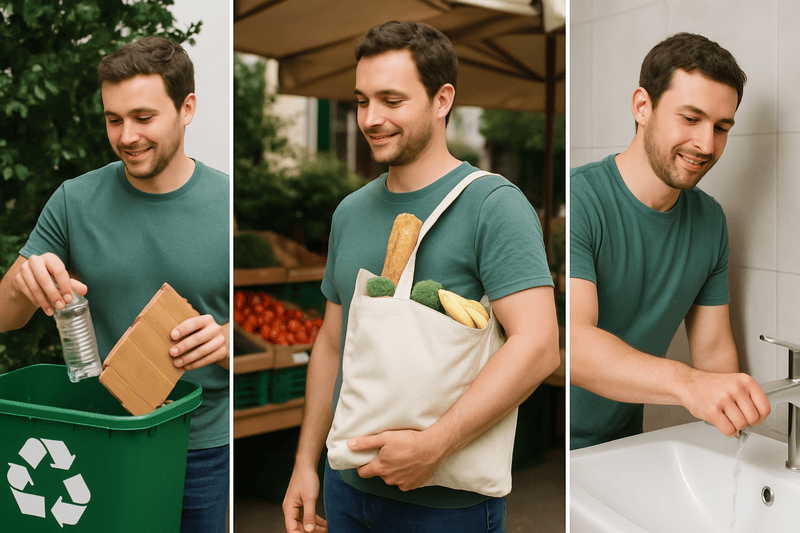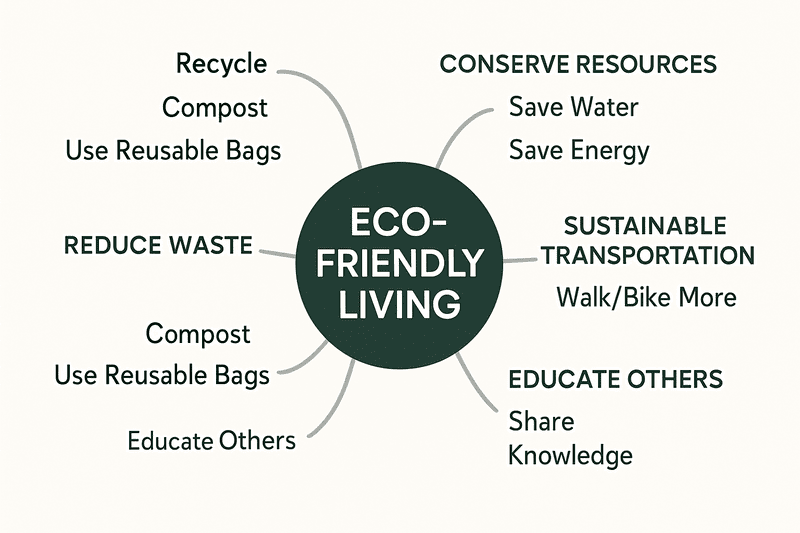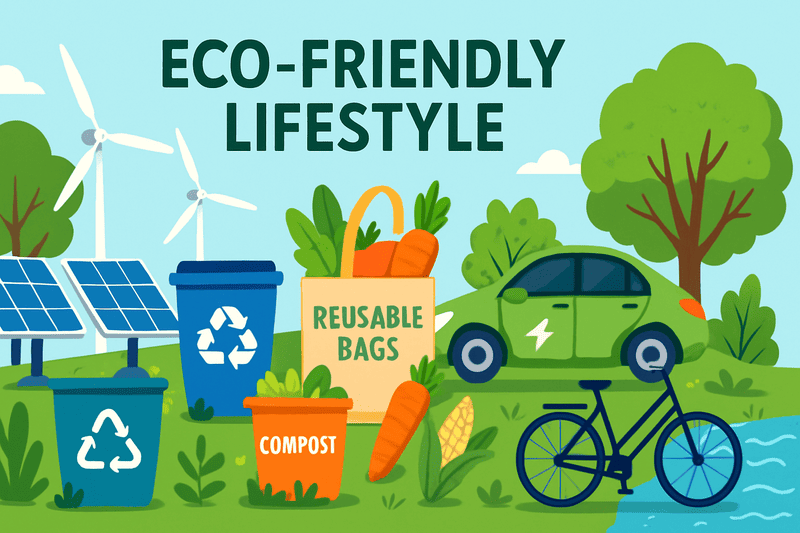Embracing a more eco-friendly lifestyle is a journey, not a destination, filled with opportunities to make positive changes for the planet. It’s about making conscious choices, big and small, that collectively reduce our environmental impact.
Some key tips for living a more eco-friendly lifestyle include reducing consumption (buy less, choose durable), minimizing waste (recycle, compost, refuse single-use items), conserving energy and water, choosing sustainable transportation, eating more plant-based foods, supporting sustainable businesses, and educating yourself and others.
Living more sustainably doesn’t require a complete overhaul overnight. It’s about incorporating greener habits into your daily routine. As someone in the packaging industry with ShineTop, where we’re increasingly focused on sustainable packaging solutions, I believe these individual efforts complement broader industry changes. Let’s explore some practical tips.
What Can We Do to Be More Eco-Friendly?
Becoming more eco-friendly involves a conscious shift in our daily habits and consumption patterns. There are numerous actions we can take, starting today, to lessen our environmental footprint.
To be more eco-friendly, we can focus on the "R’s": Reduce consumption and waste, Reuse items, Recycle properly, Refuse single-use plastics. Additionally, conserve energy and water at home, choose sustainable transportation, eat less meat, support local and sustainable businesses, and educate ourselves on environmental issues.
Making a difference starts with small, actionable steps.
Practical Steps Towards an Eco-Friendlier Life:
At Home:
- Reduce Energy Consumption:
- Switch to LED light bulbs.
- Unplug electronics when not in use (standby power adds up).
- Use energy-efficient appliances.
- Insulate your home properly.
- Wash clothes in cold water and line dry when possible.
- Lower your thermostat in winter, raise it in summer.
- Conserve Water:
- Fix leaky faucets and toilets promptly.
- Take shorter showers.
- Install low-flow showerheads and faucet aerators.
- Only run full loads in dishwashers and washing machines.
- Collect rainwater for watering plants.
- Minimize Waste:
- Reduce: Buy less overall. Choose products with minimal or no packaging. Buy in bulk to reduce packaging per unit.
- Reuse: Opt for reusable shopping bags, water bottles, coffee cups, food containers, and cloth napkins. Repurpose old items.
- Recycle: Learn your local recycling rules and sort waste correctly. Clean recyclables.
- Compost: Compost food scraps and yard waste to reduce landfill methane and create rich soil.
- Refuse: Say no to single-use plastics like straws, cutlery, and unnecessary bags.
Food Choices:
- Eat More Plant-Based Meals: Reducing meat and dairy consumption (especially red meat) can significantly lower your carbon footprint due to the resources involved in livestock farming.
- Eat Local & Seasonal: Reduces transportation emissions and supports local farmers.
- Reduce Food Waste: Plan meals, store food properly, and use leftovers.
Transportation:
- Walk, Cycle, or Use Public Transport: Whenever possible, instead of driving a car.
- Carpool: Share rides to reduce the number of vehicles on the road.
- Maintain Your Car: Keep tires properly inflated and get regular tune-ups for better fuel efficiency.
- Consider Electric or Hybrid Vehicles: For your next car purchase, if feasible.
- Fly Less: Air travel has a significant carbon footprint. Opt for trains or buses for shorter distances, or combine trips.
Shopping & Consumption:
- Buy Durable & Repairable Goods: Choose quality over quantity. Support brands that offer repairs.
- Shop Secondhand: For clothes, furniture, books, etc.
- Support Sustainable & Ethical Brands: Look for companies committed to environmental and social responsibility (e.g., B Corps, Fair Trade, brands using sustainable materials like ShineTop’s eco-packaging options).
- DIY: Make your own cleaning products, simple cosmetics, or gifts to reduce packaging and chemical exposure.
Advocacy & Education:
- Stay Informed: Learn about environmental issues and solutions.
- Speak Up: Contact your elected officials about environmental policies. Support environmental organizations.
- Share Your Knowledge: Encourage friends and family to adopt greener habits.
Every small change contributes to a larger positive impact.
How Can I Be 100% Eco-Friendly?
The aspiration to be "100% eco-friendly" is admirable, but in our current industrialized society, achieving a truly zero-impact lifestyle is virtually impossible for most people. It’s more about striving for continuous improvement and making the most significant positive changes within our means.
Being 100% eco-friendly in the modern world is an extremely challenging, if not impossible, ideal due to systemic reliance on resource-intensive infrastructure and global supply chains. However, one can strive towards near-zero waste, radical consumption reduction, self-sufficiency (growing own food, off-grid living), and complete avoidance of fossil fuels and harmful chemicals. The focus should be on significant impact reduction rather than absolute perfection.
While true 100% eco-friendliness is a lofty goal, here’s what it might entail in an idealized sense, and why it’s so difficult:
Aspects of Striving for "100% Eco-Friendly":
- Zero Waste Living: Producing absolutely no landfill waste. This involves meticulous reducing, reusing, repairing, composting everything organic, and finding ways to recycle or repurpose absolutely everything else. Extremely difficult due to non-recyclable packaging and product designs.
- Complete Self-Sufficiency:
- Growing all your own organic food.
- Generating your own renewable energy (solar, wind).
- Sourcing your own water (rainwater harvesting, well).
- Making your own clothing from natural, locally sourced fibers.
- Building your own shelter from natural, reclaimed materials.
- No Fossil Fuel Use: No driving gasoline cars, no flying, no heating with natural gas or oil, no electricity from fossil fuel power plants.
- Avoiding All Harmful Chemicals: Using only completely natural, biodegradable cleaning and personal care products (often homemade).
- Minimal Consumption: Only acquiring absolute necessities, and even then, prioritizing secondhand or items made with extreme durability and repairability from purely natural/recycled local materials.
- Localism: Sourcing everything within a very small radius to eliminate transportation emissions.
Why It’s (Practically) Impossible for Most:
- Systemic Dependence: Our societies are built on systems that are not inherently sustainable (globalized trade, fossil fuel energy, industrial agriculture, complex manufacturing).
- Product Design & Availability: Many essential products are not designed for zero waste or are not available in truly 100% eco-friendly forms. Even "natural" products often have complex supply chains.
- Infrastructure: Lack of widespread infrastructure for things like universal composting or advanced recycling of all materials.
- Cost & Accessibility: Living a truly off-grid, self-sufficient lifestyle requires specific skills, land, and often significant upfront investment, making it inaccessible to most.
- Social & Economic Realities: Jobs, family, and societal structures often require participation in systems that are not 100% eco-friendly.
A More Realistic & Impactful Approach:
Instead of aiming for an unattainable "100%," focus on making the most significant positive impact you can within your circumstances. This often means:
- Focusing on high-impact areas (reducing meat consumption, flying less, insulating your home).
- Advocating for systemic change (supporting policies and businesses that drive sustainability on a larger scale).
- Making consistent, conscious choices in your daily life.
- Progress, not perfection.
What are Five Eco-Friendly Habits?
Adopting a few key habits can make a substantial difference in reducing your environmental impact without requiring a complete lifestyle overhaul. These are often easy to integrate and have a ripple effect.
Five impactful eco-friendly habits are: 1. Consistently using reusable bags, water bottles, and coffee cups. 2. Reducing meat consumption. 3. Composting food scraps and recycling correctly. 4. Conserving energy at home (e.g., turning off lights, adjusting thermostat). 5. Choosing to walk, bike, or use public transport when possible.
These habits target major areas of resource consumption and waste generation.
Five Habits to Cultivate:
-
Embrace Reusables (Refuse Single-Use):
- Habit: Always carry reusable shopping bags. Keep a reusable water bottle and coffee cup with you or in your car/bag. Use reusable food containers for leftovers or lunches.
- Impact: Drastically reduces single-use plastic bag, bottle, and cup waste, which are major sources of pollution.
-
Reduce Meat Intake (Especially Red Meat):
- Habit: Incorporate more plant-based meals into your week (e.g., "Meatless Mondays," trying vegetarian or vegan recipes). Even reducing red meat consumption by a few meals a week makes a difference.
- Impact: Lowers your carbon footprint significantly, as livestock farming is resource-intensive (land, water, feed) and a major source of greenhouse gas emissions (methane).
-
Master Waste Sorting (Recycle Right & Compost):
- Habit: Learn your local recycling guidelines thoroughly and sort your waste correctly. Clean recyclables. Start a compost bin/pile for food scraps and yard waste (if feasible).
- Impact: Diverts valuable resources from landfills, reduces landfill methane (from organic waste), and creates nutrient-rich compost for gardens.
-
Be an Energy Saver at Home:
- Habit: Make it a routine to turn off lights when leaving a room, unplug chargers/electronics not in use, adjust your thermostat by a degree or two, and choose energy-efficient settings on appliances.
- Impact: Reduces household energy consumption, lowers greenhouse gas emissions from power plants, and saves money on utility bills.
-
Opt for Greener Transportation:
- Habit: When practical, choose to walk, cycle, or use public transportation instead of driving alone. Combine errands to reduce car trips.
- Impact: Reduces air pollution, traffic congestion, and carbon emissions from personal vehicles. Also promotes physical activity.
These five habits, if adopted widely, can create a significant collective positive change. My client Anna in Thailand is passionate about this; her brand not only uses sustainable packaging (which ShineTop helps provide) but also promotes these kinds of lifestyle tips to her customers.
How Can We Live in a More Environmentally Friendly Way?
Living in a more environmentally friendly way is about adopting a mindset of conscious consumption and mindful action, integrating sustainable practices into all aspects of our lives.
We can live in a more environmentally friendly way by consistently reducing our consumption, making thoughtful choices about what we buy (prioritizing durability, sustainability, and ethical production), minimizing waste through reuse and proper disposal, conserving resources like energy and water, supporting businesses and policies that promote environmental health, and continuously educating ourselves and advocating for positive change.
It’s a holistic approach that considers our impact on the planet in our daily decisions.
A More Holistic Path to Environmentally Friendly Living:
-
Mindful Consumption:
- Question Your Needs: Before buying something, ask if you truly need it. Can you borrow, rent, or buy it secondhand?
- Choose Quality Over Quantity: Invest in durable, well-made items that will last longer, reducing the need for frequent replacements.
- Research Brands: Support companies that are transparent about their supply chains, use sustainable materials, and adhere to ethical labor practices. (This is where brands using ShineTop’s eco-friendly packaging options can stand out).
- Avoid Fast Fashion/Disposable Culture: Opt for timeless pieces and repair clothing when possible.
-
Waste Reduction as a Priority:
- Embrace the "zero waste" philosophy as much as practical (progress, not perfection).
- Conduct a "waste audit" at home to see what you’re throwing away most and find alternatives.
- Learn DIY skills to make your own cleaners, some personal care items, or repair things.
-
Resource Stewardship:
- Be conscious of your energy and water use not just at home, but also indirectly through the products and services you consume.
- Understand the "water footprint" and "carbon footprint" of different foods and goods.
-
Connection with Nature:
- Spend time in nature. This often fosters a deeper appreciation and desire to protect it.
- Consider gardening, even on a small scale, to grow some of your own food or support pollinators.
-
Community Engagement & Advocacy:
- Support local farmers’ markets and businesses with sustainable practices.
- Get involved in local environmental initiatives or clean-up efforts.
- Voice your support for environmental protection policies to your elected officials.
-
Continuous Learning & Adaptation:
- Stay informed about environmental issues and new sustainable solutions.
- Be open to trying new habits and products.
- Share what you learn with others in a positive and encouraging way.
-
Financial Choices:
- Consider banking with or investing in institutions that support renewable energy and sustainable development, rather than those funding fossil fuels.
Living more environmentally friendly is an ongoing process of learning, adapting, and making choices that reflect a respect for the planet and future generations. It’s about recognizing that our individual actions, when multiplied, have a profound impact.
Conclusion
Living a more eco-friendly lifestyle is achievable through a series of conscious choices and habit changes focused on reducing consumption, minimizing waste, conserving resources, and making sustainable choices in food, transport, and purchasing. While becoming "100% eco-friendly" is a challenging ideal, adopting key habits like using reusables, reducing meat intake, proper waste sorting, energy conservation, and greener transport can make a significant positive impact. It’s about continuous effort and a commitment to progress over perfection.












